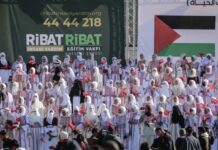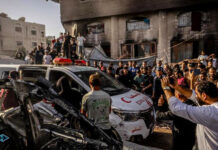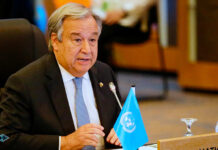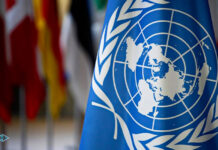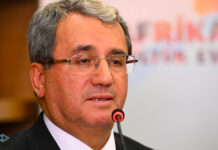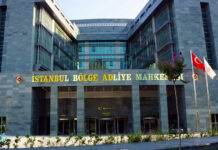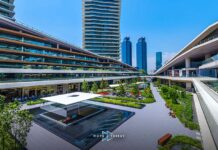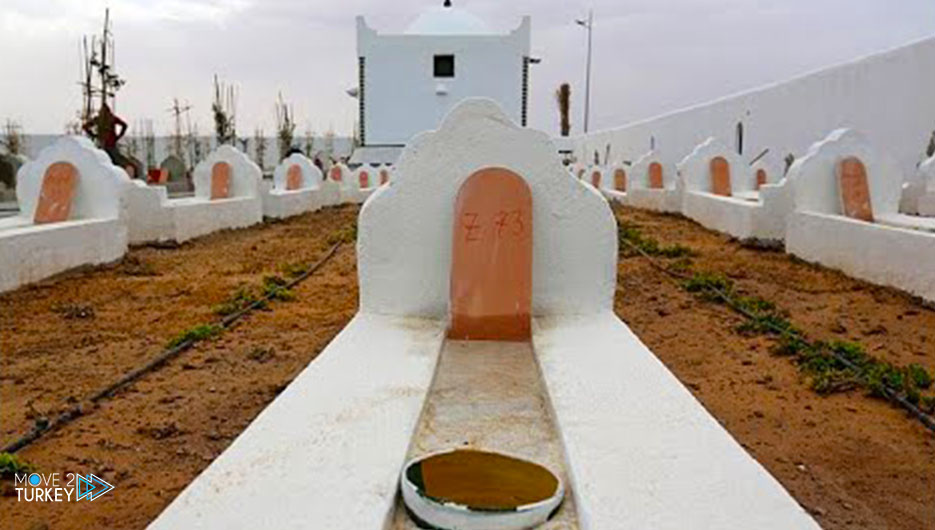
Closer to the palace than to the cemetery, it was built with the touches of the Algerian plastic artist, Rachid Al-Quraishi, in the Tunisian city of Zarzis.
Where he built a cemetery to bury the bodies of irregular migrants who were thrown by the Mediterranean on the southern coasts of Tunisia in a way that guarantees their human dignity.
The cemetery, known as the “Garden of Africa”, is located in the outskirts of the Tunisian city of Zarzis (southeast), and contains 500 graves dedicated to the burial of irregular immigrants.
According to Al-Quraishi (in his sixties), “the cemetery is like a palace in this world that guarantees the burial of immigrants with dignity before the other palace in the hereafter.”
-Advertisement-
An idea that has taken shape since 2018
The Algerian artist said, “The idea of establishing the cemetery crystallized since 2018 when my daughter saw a media report dealing with the difficult situation in which migrants are buried in a cemetery in Zarzis.
She called me and suggested that I build a new cemetery that would guarantee their dignity.”
He added, “At first, I did not believe that there was a cemetery for irregular immigrants in the middle of a dump, so I decided to move with my daughter to the city of Zarzis, where I witnessed a horrific scene.”
Years ago, due to the failure of the local authorities in Zarzis to provide a place to bury these migrants, Tunisian citizen Shams Al-Din Marzouk volunteered to bury the bodies of the migrants in the city’s “Ghurabaa” cemetery, which suffers from major shortcomings.
-Advertisement-
To ensure the dignity of immigrants
On an area of 2,500 square meters, the Algerian artist built the fenced cemetery over the entire area, which in turn is divided into 8 parts, and each part contains dozens of tombs.
Flowers decorated the graves of immigrants, and there is a sign on each grave bearing the name of the deceased if he was identified before burial and his gender and the date of his discovery.
To ensure the dignity of immigrants, the Algerian artist built a place of prayer and supplication for immigrants of different faiths.
Al-Quraishi said: “This cemetery contains the bodies of all immigrants, whether they are Muslims, Christians or even Buddhists.
Some of the migrants who were found are from Bangladesh, for example, as I promised my Lord that all the graves will be the same, and there is no difference.”
-Advertisement-
Al-Quraishi’s upbringing in a family tending to the Tijaniya Sufi school (one of the Sufi orders) contributed to his personality, which beliefs in inequality and does not differentiate between people their nationality, color, or any other consideration.
By constructing this cemetery, the Algerian artist aims to provide an opportunity for the families of the missing to identify their relatives.
In this regard, he continued, “Even if only 10 migrants were identified from among the entire graves of migrants in this cemetery, this is considered a positive thing.”
He continued, “My older brother drowned in the Mediterranean years ago, and we have not found his body until today, and even my mother when she was on her deathbed before her death in 2011, was asking about him.”
And he added: “A mother’s separation from her son in the presence of a grave is much easier than separation without the presence of any grave.”
For his part, Al-Mongi Selim, head of the local Red Crescent Authority in Medenine Governorate, stated that: “A DNA sample will be taken for each immigrant’s body to provide the possibility for his family to identify him.”
Selim added that “months ago, a Libyan family was able to identify the bodies of their two sons in this cemetery through DNA analysis.”
-Advertisement-
art and humanity
The artist Al-Quraishi alone sponsored the purchase of the land and the construction of the cemetery of immigrants through the proceeds of his fine works.
He explained, “We have a lot of works on display in the world, such as the United States and Britain.
I recommended those who sell my works in exhibitions to provide the necessary amount to ensure that I fulfill my contract with God in building a cemetery to bury immigrants with dignity.”
On the mixture between his plastic work and the human side, Al-Quraishi said, “I differentiate between my work as a plastic artist and what I do here.
Some of my friends asked me if I would display some of your paintings in the cemetery, so I answered them, “How can I advertise myself in this cemetery by displaying my work here!”
-Advertisement-
With dozens of dead bodies of immigrants continuing to arrive on the coast of Zarzis, Rashid Al-Quraishi is seeking to expand the cemetery.
According to Mongi Selim, “the cemetery has a capacity of 500 graves, and now contains only 200 graves.”
The Tunisian official stated that “every year, between 150 and 200 bodies of irregular migrants arrive on the country’s southern coasts.”
The Tunisian coast is an important transit point in North Africa for irregular migrants towards Europe.
Over the past years, the sea has sent hundreds of migrants to the coast of Tunisia, after they drowned in the Mediterranean.

